
Have you seen the viral post that’s been going around this summer written by a woman in England who lost her adorable French bulldog to Heat Stroke? As you might imagine, this story and the events it describes saddens me… but not only for the reason you might imagine.
Frenchie Heat Stroke
You see, Henry (that was this adorable little Frenchie’s name), didn’t suffer from Heat Stroke after having been left in a parked car, he died from another cause of Heat Stroke... one that is even more common and one which far too many people are still unaware of. 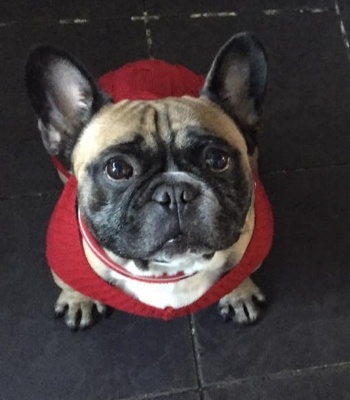
The cause of Henry’s Heat Stroke and subsequent death was a condition called “Brachycephalic Syndrome” in the U.S., or “Brachycephalic Obstructive Airway Syndrome (B.O.A.S.)” in the U.K. Regardless of which side of the proverbial “pond” a dog lives on though, this is a potentially devastating condition where affected dogs have one or multiple problems with their respiratory (breathing) system as listed below.
Note: Detail of these 5 conditions is provided further along in this article.
- Stenotic nares
- Everted saccules
- Elongated soft palate
- Hypoplastic trachea
- Nasopharyngeal turbinates
What saddens me about Henry’s death, aside from the death itself and heartbreak it caused, is the fact that Brachycephalic Syndrome is well known amongst breeders and we veterinarians, yet far-too-few discuss it with people who have the very dogs that suffer from it or recommend the corrective surgery for it. This lack of education and awareness isn’t just prolonging suffering for these dogs, it also leads to additional health problems and – as in Henry’s case – is also literally killing dogs!
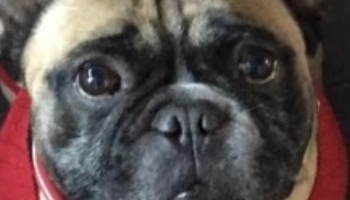 .
. 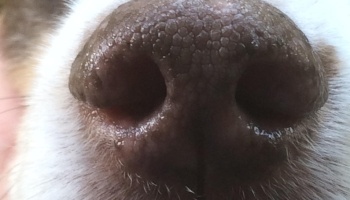
Notice how narrow Henry's left nostril is compared to the right one, which itself is narrow compared to a dog with
a "normal nose," pictured here for comparison.
Don’t think your flat-faced dog suffers from brachycephalic syndrome?
You wouldn’t be alone! According to this study from The Royal Veterinary College (my fantastic alma mater), a majority of owners (58%) of dogs affected by Brachycephalic Syndrome didn’t recognize that their dogs were showing signs of the condition.
You know those "adorable" snorting and gurgling sounds many bulldogs and other flat-faced dogs make? They're actually a pretty good indication that the dog is suffering from chronic breathing difficulties and that the dog has at least one component of Brachycephalic Syndrome. Not so "adorable" anymore, is it?
Brachycephalic Syndrome or Brachycephalic Obstructive Airway Syndrome – What Is It?
As mentioned above, Brachycephalic (Obstructive Airway) Syndrome is the result of a group different of respiratory abnormalities that makes it more difficult for affected dogs to breathe normally and comfortably. Below are the five abnormalities that can make up the condition, with additional information and detail for all. Note that affected dogs may have just one, all five, or any combination of these abnormalities, and all can be to varying degrees. Also note that this condition also affects brachycephalic cats (e.g. Persians, Himalayans, etc.), not just brachycephalic dogs (e.g. English Bulldogs, French Bulldogs, Pugs, Boxers, Shih Tzus, and others).
Stenotic nares
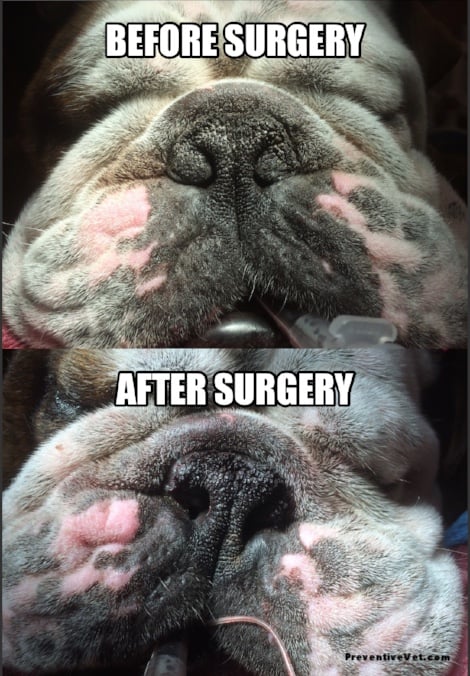
The nares are more commonly known as the nostrils, and stenotic means constricted or narrowed. Literally, this means that an affected dog’s nostrils are narrower than they should be to allow the dog to breathe easily through them. Think of how crummy you feel when trying to breathe through your nose when you’ve got a bad cold or allergies—not easy or fun, right?
The image to the right is an example of the before and after of nare (nostril) surgery. Notice how (practically) non-existent the dog's nostrils are in the "before" picture and compare how much wider they now are in the "after." This seemingly small change can make a HUGE difference in the comfort and quality of life of a dog.
If you go back up and look at the picture of Henry now you'll notice how much more "stenotic" his left (right as you're looking at him) nostril is compared to his right. Do you see that?
Everted laryngeal saccules
The pockets of tissue in front of the larynx (the “voice box”) get sucked into the windpipe when an affected dog breathes in. This leads to a (partial) obstruction of the dog’s windpipe (trachea), depriving them of the oxygen they need to live and causing breathing difficulty and distress.
Hypoplastic trachea
The trachea, or “windpipe,” is narrower than it should be, given the size of the dog. Think of it this way… snorkeling with a cocktail straw, rather than a snorkel. Which would you choose? Kinda gives you anxiety and a suffocating feeling just thinking about it. Doesn't it?
Elongated soft palate
The soft palate is the tissue that separates a dog’s nasopharynx from his oropharynx, or in more basic or simplistic terms… his nasal cavity from his mouth. In affected dogs, the end of the soft palate is too close to the windpipe, easily getting sucked in and stuck when the dog breathes in. This leads to (partial) obstruction of the windpipe, with resulting difficulty and distress during breathing.
Nasopharyngeal turbinates
The turbinate bones are the bones that are normally present in the nasal cavities of dogs (and cats, and people) that help to filter and humidify the air they breathe in. Their presence beyond the nasal cavities, in the nasopharynx (“back of the throat”), though can increase resistance to a dog getting a breath and can contribute to the breathing difficulties experienced by many brachycephalic animals.
How Does Brachycephalic Syndrome Affect Dogs?
Dogs with Brachycephalic Syndrome have to work harder than other dogs to do something that’s so important and crucial to life (let alone a good quality of life)… breathing. As if that wouldn’t be bad enough, along with the breathing difficulties and distress that Brachycephalic Syndrome causes affected dogs, it also increases their risk of developing a host of other problems (some of which are listed and described below)… none of them are fun or kind.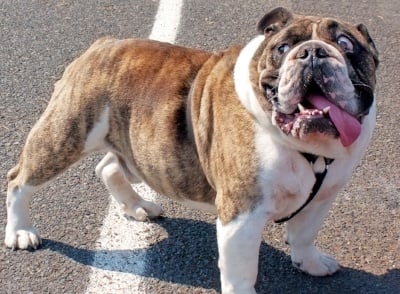
- Heat Stroke, because dogs depend on their respiratory system (panting) to cool themselves off, dogs with Brachycephalic Syndrome are at greater risk of developing (and suffering and dying from) Heat Stroke, like Henry did. Though "hot car cases" get lots of media attention (and it's good that they do!), most Heat Stroke cases are a result of dogs out for a walk or play session on a warm day, not from being left in a car!
- Heart arrhythmias, both because the increased effort a dog with Brachycephalic Syndrome must exert to breath in causes an increase in vagal tone (the Vagus nerve does MANY things within the body, one of which is to slow the heart rate) – leading to bradyarrhythmias (slow heart rates) – and also because of the fact that their breathing difficulties cause them to use more oxygen, while at the same time making it less likely that they can actually breathe in all the oxygen they need (the heart muscle cells, like the other cells within their body, require oxygen to function most efficiently).
- Excessive gassiness and flatulence, because affected dogs often swallow a lot of air as they are working harder to breathe. The air that goes into their stomach and digestive tract needs to go somewhere, and it’s often out their back end, and often in a room-clearing fashion!
- Acid reflux and frequent vomiting or regurgitation, because of the constant struggle to breathe and the changes in pressures between the chest and abdominal cavities that doing so generates, an affected dog can develop a hiatal hernia, where a portion of the stomach abnormally slides back into the esophagus. (Learn how to recognize the difference between vomiting and regurgitation. It’s important to know.)
Brachycephalic Syndrome – What Can Be Done?
First and foremost, it’s imperative that those with dogs suffering from Brachycephalic Syndrome recognize it and appreciate the problems associated with it… even if the “only” problem their dog has is chronic breathing difficulties. They’re still suffering as a result of their condition.
Awareness is truly crucial, so please have your brachycephalic dog (or cat) evaluated, and please share this article to ensure that your brachycephalic pet-owning friends and family can become aware, too.
To ensure the best comfort, safety, and quality of life for a brachycephalic pet, here's a list of the things that owners of these pets need to pay extra special attention to:
Weight: For all dogs with any degree of Brachycephalic Syndrome, weight management is imperative! A brachycephalic cat or dog that is obese or otherwise carrying around more weight than they should be is at higher risk of suffering from their Brachycephalic Syndrome, regardless of the severity of their condition, than a brachycephalic pet who is at their ideal body condition.
Unfortunately, similar to the lack of recognition of a pet’s signs of Brachycephalic Syndrome by pet owners, over 90 percent of pet owners of overweight pets failed to recognize that their pets were overweight!
Temperature: Since dogs cool themselves off through their respiratory system, not by sweating (as we do), dogs with Brachycephalic Syndrome have far less tolerance for warm or hot environments. This applies not just to cars and other enclosed spaces, but also within their own homes!
In many climates, home air conditioning is a must for those with brachycephalic pets. Strict attention must be paid to keeping their environment cool and comfortable. This is (part of the reason) why many airlines refuse to transport brachycephalic pets, or at least have severe (and important) restrictions on their transport.
Stress: Steps must be taken to keep pets with Brachycephalic Syndrome from becoming overly stressed or anxious, since stressed and anxious pets tend to rely on their respiratory system even more, by panting or open-mouth breathing. This includes stress during travel, during fireworks and thunderstorms, and even during visits to the vet’s office.
Surgery: Since the severity of an affected dog’s degree of Brachycephalic Syndrome can vary significantly, not all dogs with this syndrome need surgery. Your dog’s behavior and your veterinarian’s guidance (or that of a board-certified veterinary surgeon) will be your best guide.
Your veterinarian can easily evaluate the width of your dog’s nostrils (you can even do it yourself right now – just look!). However, the only way for them to fully evaluate your dog’s soft palate, laryngeal saccules, and trachea width is under sedation or anesthesia. And the only ways to really evaluate for abnormal turbinate bones is either with a CT scan or rhinoscopy. See this article for more information on the surgical procedures that can help pets with Brachycephalic Syndrome.
While every dog with Brachycephalic Syndrome isn’t necessarily a good candidate for the surgery, and while not all pet owners can afford the procedure, everybody who has a brachycephalic dog should have their dog evaluated for the components of this syndrome.
While the width of the nostrils can be easily evaluated in an awake pet, the length of the soft palate, presence of everted saccules, and the other components require sedation/anesthesia (and, in the case of nasopharyngeal turbinates, advanced imaging, like a CT scan or MRI).
Having a brachycephalic pet evaluated earlier in their life is better than later, so at the time of a dog's spay/neuter is often a great starting point. However, if a dog or cat is severely affected by their condition, then even earlier evaluation and surgical treatment is necessary. Talk to your veterinarian specifically about this condition and what treatment options might be best for your brachycephalic pet.



